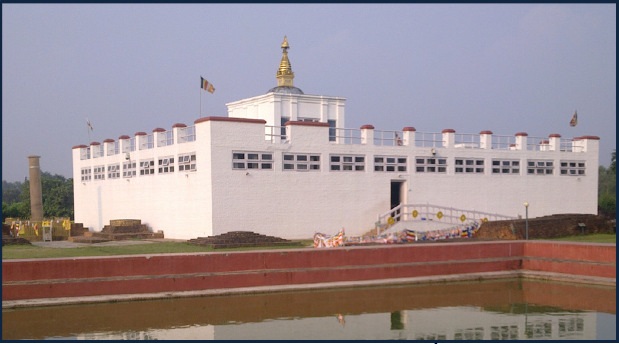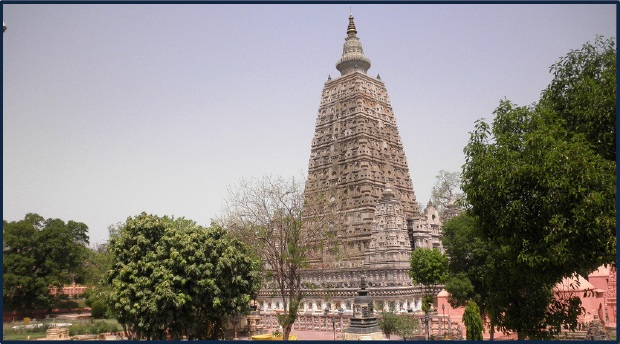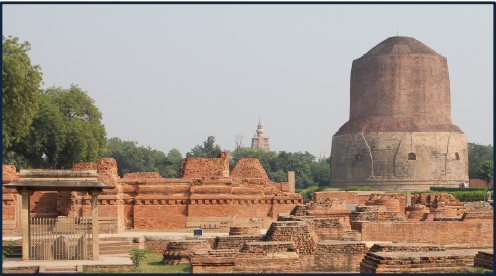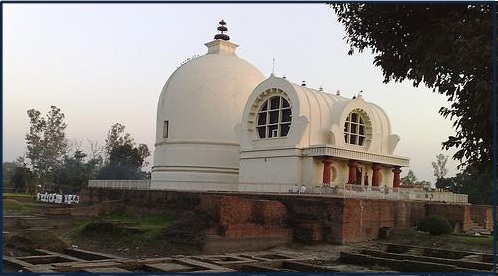These four holy sites refer to those destinations that have been witness to some important events in the life of the Buddha.
They are intrinsically connected to the life of the Buddha and have utmost significance in the development of Buddhism.
Lumbini (southern Nepal)
 Lumbini is one of the holiest places of Buddhist pilgrims from a very early period as it is the place where Gautam Buddha was born. Suddhodana, father of Gautama Buddha, was the king of the Shakya dynasty.
In the month of May, 642 BC, Maya Devi on was on her way from her husband's capital of Tilaurakot to her family home in Devadaha, she gave birth to the child while resting in Lumbini under a sal tree.
In 249 BC, when the Indian Emperor Ashoka visited Lumbini, he constructed four stupas and a stone pillar with a figure of a horse on top.
Lumbini is one of the holiest places of Buddhist pilgrims from a very early period as it is the place where Gautam Buddha was born. Suddhodana, father of Gautama Buddha, was the king of the Shakya dynasty.
In the month of May, 642 BC, Maya Devi on was on her way from her husband's capital of Tilaurakot to her family home in Devadaha, she gave birth to the child while resting in Lumbini under a sal tree.
In 249 BC, when the Indian Emperor Ashoka visited Lumbini, he constructed four stupas and a stone pillar with a figure of a horse on top.
Major attractions are:
(1) the Sanctum Sanctorum of the Buddha's birth place,
(2) the Maya Devi temple dedicated to the birth of the Lord Buddha and his mother, and
(3) the sacred pool, Pushkarni, is believed Maya Devi toke a holy dip before giving birth to the Buddha.
• Location: In the foothills of the Himalayas by the Indian border
• Climate: Cold (Nov to Jan); Summer - Pleasant(May and Sept
• Best time to visit : Oct to May.
Bodh Gaya, (Bihar, India)
 Bodh Gaya was known as Uruvela, Sambodhi, Vajrasana or Mahabodhi, it was believed to be used as a name of this location since the 18th century CE.
Bodh Gaya is famous for being the place where Sakyamuni attained enlightenment and became the Buddha while seated under the Bodhi Tree.
The first temple was built by Emperor Asoka at the site of the Bodhi Tree in the 3rd century B.C. The present temple dates from the 5th or 6th centuries.
It is one of the earliest Buddhist temples built entirely in brick.
Bodh Gaya was known as Uruvela, Sambodhi, Vajrasana or Mahabodhi, it was believed to be used as a name of this location since the 18th century CE.
Bodh Gaya is famous for being the place where Sakyamuni attained enlightenment and became the Buddha while seated under the Bodhi Tree.
The first temple was built by Emperor Asoka at the site of the Bodhi Tree in the 3rd century B.C. The present temple dates from the 5th or 6th centuries.
It is one of the earliest Buddhist temples built entirely in brick.
The Mahabodhi Temple Complex consists of the main temple and 7 sacred places:
(1). giant Bodhi Tree under which the Buddha spent his 1st week after enlightenment,
(2) Animeshlochan Chaitya or prayer hall where buddha spent his 2nd week after enlightenment,
(3) Ratnachakrama or Jewelled Ambulatory where Buddha spent his 3rd week walking 18 paces back and forth in an area,
(4) Ratnaghar Chaitya where Buddha spent his 4th week.
(5) Ajapala Nigrodh Tree, under which Buddha meditated during his 5th week, answering the queries of Brahmins,
(6) Buddha spent the 6th week next to the Lotus Pond, and
(7). Buddha spent the 7th week under the Rajyatana Tree.
• Location: 10 Kilometers from the holy city of Varanasi.
• Climate: Summer (Mar to Jun) - Warm; Monsoon (Jul to Aug)- Warm; Winter (Nov to Feb) - Cool & Pleasant.
• Best time to visit: Oct to Feb
Sarnath (Uttar Pradesh, India)
 Sarnath was the first site where Buddha gave the first sermon in 528 BCE. The Buddha's teachings at Sarnath further led to the establishment of the Buddhist sangha.
The main attraction of this holy site is the Choukhandi Stupa where the Buddha delivered his first sermon to the five disciples, including Ananda. Other attractions include:
(1) Ashoka Pillar built by Ashoka to commemorate his visit,
(2) Sarnath Museum that displays the lion capital, Buddhist Sarnath artifacts, manuscripts, and statues (closed on Friday), and
(3) Mulagandha Kuti Vihar is known for its intricate frescoes from Buddhist literature, by Kosetsu Nosu, a famous Japanese artist.
Sarnath was the first site where Buddha gave the first sermon in 528 BCE. The Buddha's teachings at Sarnath further led to the establishment of the Buddhist sangha.
The main attraction of this holy site is the Choukhandi Stupa where the Buddha delivered his first sermon to the five disciples, including Ananda. Other attractions include:
(1) Ashoka Pillar built by Ashoka to commemorate his visit,
(2) Sarnath Museum that displays the lion capital, Buddhist Sarnath artifacts, manuscripts, and statues (closed on Friday), and
(3) Mulagandha Kuti Vihar is known for its intricate frescoes from Buddhist literature, by Kosetsu Nosu, a famous Japanese artist.
Sarnath is 10 kilometers away from Varanasi (20 minutes to the airport) and is easily accessible by air, road or rail route.
• Location: 10 Kilometers from the holy city of Varanasi.
• Climate: Winter: Cold (Oct to Jan), Monsoon : Warm (Jul and Aug), Summer : Hot (Apr to Jun)
• Best time to visit: Oct to Feb
Kushinagar/Kushinara, (Uttar Pradesh, India)
 Kushinagar is the site of the Buddha's paranibbana. In the Buddha's period, it was a part of the Malla kingdom and known as Kusinara.
This city was one of the six most prosperous Indian cities at the time. The Buddha visited Kushinagar in the 6th and 9th years after attaining his enlightenment.
During these visits, the Buddha delivered several key sermons at Kaushambi, therefore making it a significant center of Buddhist studies.
Following the Buddha’s maha-parinirvana, a number of stupas and viharas were constructed in the following period. Ashoka built a numerous of Buddhist statues here.
The Chinese travelers including Fa-Hien, Huen-Tsang, and I-tsing all paid a visit to this site. The main attractions include:
(1) Mahaparinirvana Temple where the 6-meter long Buddha status shows the dying Buddha reclining on His right side,
(2) Ramabhar Stupa (49 feet height) is believed to be the place where the Buddha was cremated,
(3) Nirvana Stupa is a 2.74-meter height brick structure where the last remains of Lord Buddha were deposited,
(4) Mathakuar Shrine where the Buddha delivered his last sermon, and
(5) the ruins of old Kaushambi.
Kushinagar is the site of the Buddha's paranibbana. In the Buddha's period, it was a part of the Malla kingdom and known as Kusinara.
This city was one of the six most prosperous Indian cities at the time. The Buddha visited Kushinagar in the 6th and 9th years after attaining his enlightenment.
During these visits, the Buddha delivered several key sermons at Kaushambi, therefore making it a significant center of Buddhist studies.
Following the Buddha’s maha-parinirvana, a number of stupas and viharas were constructed in the following period. Ashoka built a numerous of Buddhist statues here.
The Chinese travelers including Fa-Hien, Huen-Tsang, and I-tsing all paid a visit to this site. The main attractions include:
(1) Mahaparinirvana Temple where the 6-meter long Buddha status shows the dying Buddha reclining on His right side,
(2) Ramabhar Stupa (49 feet height) is believed to be the place where the Buddha was cremated,
(3) Nirvana Stupa is a 2.74-meter height brick structure where the last remains of Lord Buddha were deposited,
(4) Mathakuar Shrine where the Buddha delivered his last sermon, and
(5) the ruins of old Kaushambi.
The nearest airports are at Allahabad(50 kilometers), Varanasi(150 kilometers) and Kanpur(160 kilometers).
• Location : 50 kilometers west of Allahabad, the state capital of Uttar Pradesh, with its district headquarter at Manjhanpur.
• Climate : Nov to Feb - Cold; Summer - Apr to Jun - Hot; Monsoon - Jul to September - Good & pleasant.
• Best Time to Visit : Oct to March
|

 Lumbini is one of the holiest places of Buddhist pilgrims from a very early period as it is the place where Gautam Buddha was born. Suddhodana, father of Gautama Buddha, was the king of the Shakya dynasty.
In the month of May, 642 BC, Maya Devi on was on her way from her husband's capital of Tilaurakot to her family home in Devadaha, she gave birth to the child while resting in Lumbini under a sal tree.
In 249 BC, when the Indian Emperor Ashoka visited Lumbini, he constructed four stupas and a stone pillar with a figure of a horse on top.
Lumbini is one of the holiest places of Buddhist pilgrims from a very early period as it is the place where Gautam Buddha was born. Suddhodana, father of Gautama Buddha, was the king of the Shakya dynasty.
In the month of May, 642 BC, Maya Devi on was on her way from her husband's capital of Tilaurakot to her family home in Devadaha, she gave birth to the child while resting in Lumbini under a sal tree.
In 249 BC, when the Indian Emperor Ashoka visited Lumbini, he constructed four stupas and a stone pillar with a figure of a horse on top.  Bodh Gaya was known as Uruvela, Sambodhi, Vajrasana or Mahabodhi, it was believed to be used as a name of this location since the 18th century CE.
Bodh Gaya is famous for being the place where Sakyamuni attained enlightenment and became the Buddha while seated under the Bodhi Tree.
The first temple was built by Emperor Asoka at the site of the Bodhi Tree in the 3rd century B.C. The present temple dates from the 5th or 6th centuries.
It is one of the earliest Buddhist temples built entirely in brick.
Bodh Gaya was known as Uruvela, Sambodhi, Vajrasana or Mahabodhi, it was believed to be used as a name of this location since the 18th century CE.
Bodh Gaya is famous for being the place where Sakyamuni attained enlightenment and became the Buddha while seated under the Bodhi Tree.
The first temple was built by Emperor Asoka at the site of the Bodhi Tree in the 3rd century B.C. The present temple dates from the 5th or 6th centuries.
It is one of the earliest Buddhist temples built entirely in brick.  Sarnath was the first site where Buddha gave the first sermon in 528 BCE. The Buddha's teachings at Sarnath further led to the establishment of the Buddhist sangha.
The main attraction of this holy site is the Choukhandi Stupa where the Buddha delivered his first sermon to the five disciples, including Ananda. Other attractions include:
(1) Ashoka Pillar built by Ashoka to commemorate his visit,
(2) Sarnath Museum that displays the lion capital, Buddhist Sarnath artifacts, manuscripts, and statues (closed on Friday), and
(3) Mulagandha Kuti Vihar is known for its intricate frescoes from Buddhist literature, by Kosetsu Nosu, a famous Japanese artist.
Sarnath was the first site where Buddha gave the first sermon in 528 BCE. The Buddha's teachings at Sarnath further led to the establishment of the Buddhist sangha.
The main attraction of this holy site is the Choukhandi Stupa where the Buddha delivered his first sermon to the five disciples, including Ananda. Other attractions include:
(1) Ashoka Pillar built by Ashoka to commemorate his visit,
(2) Sarnath Museum that displays the lion capital, Buddhist Sarnath artifacts, manuscripts, and statues (closed on Friday), and
(3) Mulagandha Kuti Vihar is known for its intricate frescoes from Buddhist literature, by Kosetsu Nosu, a famous Japanese artist.  Kushinagar is the site of the Buddha's paranibbana. In the Buddha's period, it was a part of the Malla kingdom and known as Kusinara.
This city was one of the six most prosperous Indian cities at the time. The Buddha visited Kushinagar in the 6th and 9th years after attaining his enlightenment.
During these visits, the Buddha delivered several key sermons at Kaushambi, therefore making it a significant center of Buddhist studies.
Following the Buddha’s maha-parinirvana, a number of stupas and viharas were constructed in the following period. Ashoka built a numerous of Buddhist statues here.
The Chinese travelers including Fa-Hien, Huen-Tsang, and I-tsing all paid a visit to this site. The main attractions include:
(1) Mahaparinirvana Temple where the 6-meter long Buddha status shows the dying Buddha reclining on His right side,
(2) Ramabhar Stupa (49 feet height) is believed to be the place where the Buddha was cremated,
(3) Nirvana Stupa is a 2.74-meter height brick structure where the last remains of Lord Buddha were deposited,
(4) Mathakuar Shrine where the Buddha delivered his last sermon, and
(5) the ruins of old Kaushambi.
Kushinagar is the site of the Buddha's paranibbana. In the Buddha's period, it was a part of the Malla kingdom and known as Kusinara.
This city was one of the six most prosperous Indian cities at the time. The Buddha visited Kushinagar in the 6th and 9th years after attaining his enlightenment.
During these visits, the Buddha delivered several key sermons at Kaushambi, therefore making it a significant center of Buddhist studies.
Following the Buddha’s maha-parinirvana, a number of stupas and viharas were constructed in the following period. Ashoka built a numerous of Buddhist statues here.
The Chinese travelers including Fa-Hien, Huen-Tsang, and I-tsing all paid a visit to this site. The main attractions include:
(1) Mahaparinirvana Temple where the 6-meter long Buddha status shows the dying Buddha reclining on His right side,
(2) Ramabhar Stupa (49 feet height) is believed to be the place where the Buddha was cremated,
(3) Nirvana Stupa is a 2.74-meter height brick structure where the last remains of Lord Buddha were deposited,
(4) Mathakuar Shrine where the Buddha delivered his last sermon, and
(5) the ruins of old Kaushambi.